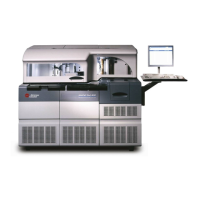
Do you have a question about the Beckman Coulter UniCel DxC 600 and is the answer not in the manual?
| Type | Clinical Chemistry Analyzer |
|---|---|
| Sample Types | Serum, Plasma, Urine |
| Power Supply | 100-240 VAC, 50/60 Hz |
| Number of Tests | 100+ |
| Weight | Approximately 80 kg |
Summarizes hazards associated with the DxC System, including individual hazards for specific procedures.
Warns against tampering with bar code reader housing due to laser hazard.
Advises observance of laboratory policies for handling infectious and pathogenic materials.
Describes the symbol indicating the analyzer power is ON when the switch is in the down position.
Symbol indicates high voltage presence and risk of electric shock in the area.
Explains the meaning and usage of WARNING, CAUTION, IMPORTANT, and NOTE symbols in documentation.
Outlines the main components of the UniCel DxC System, including Sample Handling, Modular Chemistry, and others.
Describes the Sample Handling system, composed of racks, autoloader, shuttle, bar code reader, etc.
Details the Modular Chemistry system, comprising reagent storage, ratio pump, sample probe, flow cell, and reaction modules.
Explains the Cartridge Chemistry Reagent Handling system, including reagent cartridges, carousel, probe, and mixer.
Covers the process of preparing samples, including minimum volume requirements and sample rack compatibility.
Explains the usage of reserved racks for specific tests like HbA1c and IBCT, and their configuration.
Allows operators to assign user names, passwords, and privilege levels, enabling/disabling security for system functions.
Details how to install and configure tests from a list of available chemistries for display and selection.
Lists Host communications parameters, options, and default values for ASTM, LX20/DxC, and CX7 compatible systems.
Describes the process of loading reagents onto DxC systems and calibrating chemistries using the Reagent Load/Calibration screen.
Explains how system calibration is used to standardize sample analysis and when system calibration is required.
Provides instructions on how to calibrate DxC chemistries using bar code labels or assigned calibrator racks.
Offers capabilities for monitoring system and chemistry performance through real-time analysis of control data using Westgard rules.
Guides users on defining controls, including control name, lot number, sample type, and chemistry selection.
Describes procedures for running control samples, with or without bar code labels, and with Auto Generation of Control enabled.
Explains how samples can be identified using Sample ID, rack/cup position, or both, and how setup options affect cursor start and required fields.
Details the process of programming samples, including test selection, sample description, and batch programming.
Provides instructions on clearing sample programming information from the system when racks are no longer available or need reprogramming.
Explains how to recall results by an individual Sample ID or a range of Sample IDs, and output options.
Describes how to view recalled results on the screen, including navigating through pages and updating with new results.
Details how to send results to the host computer, either whole groups of data or individual sample data.
Guides users through defining user-defined reagents by specifying chemistry parameters, processing parameters, and error detection limits.
Covers defining a chemistry test name, allowable entries, and reaction types for user-defined reagents.
Explains reagent blank, reaction, initial rate, and multipoint span limits for error detection in user-defined reagents.
Discusses the importance of performing maintenance by trained personnel for optimal performance and reducing service calls.
Outlines procedures for cleaning sample/reagent probes, mixers, and flow cells twice weekly to prevent contamination.
Covers weekly maintenance tasks such as checking reagent levels, cleaning cuvette wiper and probes, and checking calibration span.
Details monthly tasks like replacing alkaline buffer, cleaning cup modules, cleaning mixers, and calibrating lamps/sensors.
Provides a high-level summary of system temperatures, power, hydropneumatic, and ICS/Smart Module status in real-time.
Lists high-level system commands used to control the instrument and printer, including Home, Pause, Stop Print, and Shutdown.
Explains the Home command for moving mechanical assemblies to a known position and priming the system, useful for recovering from motion errors.
Describes the Pause function to prevent new tests from starting without wasting sample or reagent, allowing interruption of samples in process.
Allows manual priming of entire subsystems or individual components to prepare them for system readiness.
Provides a record of events and errors, useful for troubleshooting problems encountered while operating the instrument.
Offers the ability to store data to a diskette for later use or to restore previously backed-up data into the system.
Describes calibration reports for various chemistries and explains fields used during calibration, including error flags.
Details how the DxC system sets calibration based on two or four calibrator replicates for linear photometric chemistries.
Explains the calibration process for linear photometric chemistries, including back-to-back checks and calibrator range checks.
Lists common system error messages, their pop-up text, Event Log entries, descriptions, and recommended corrective actions.